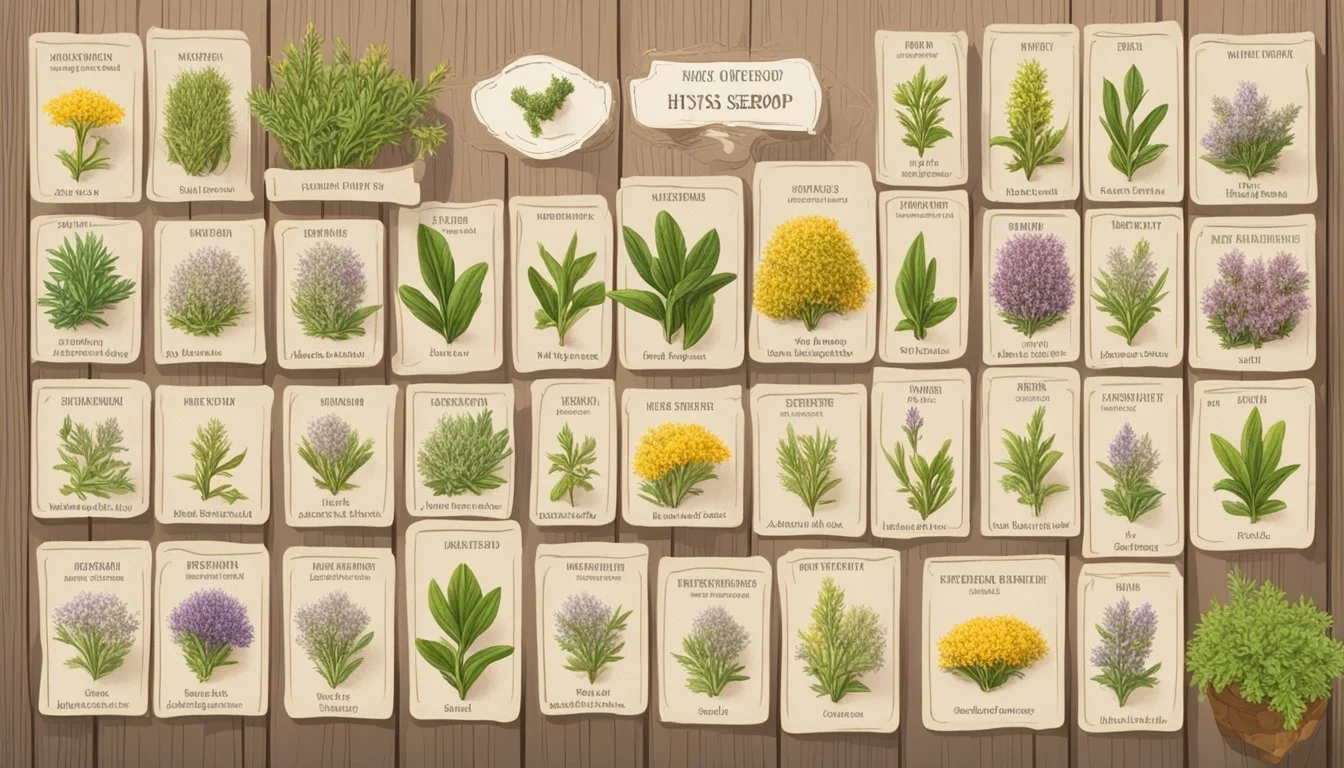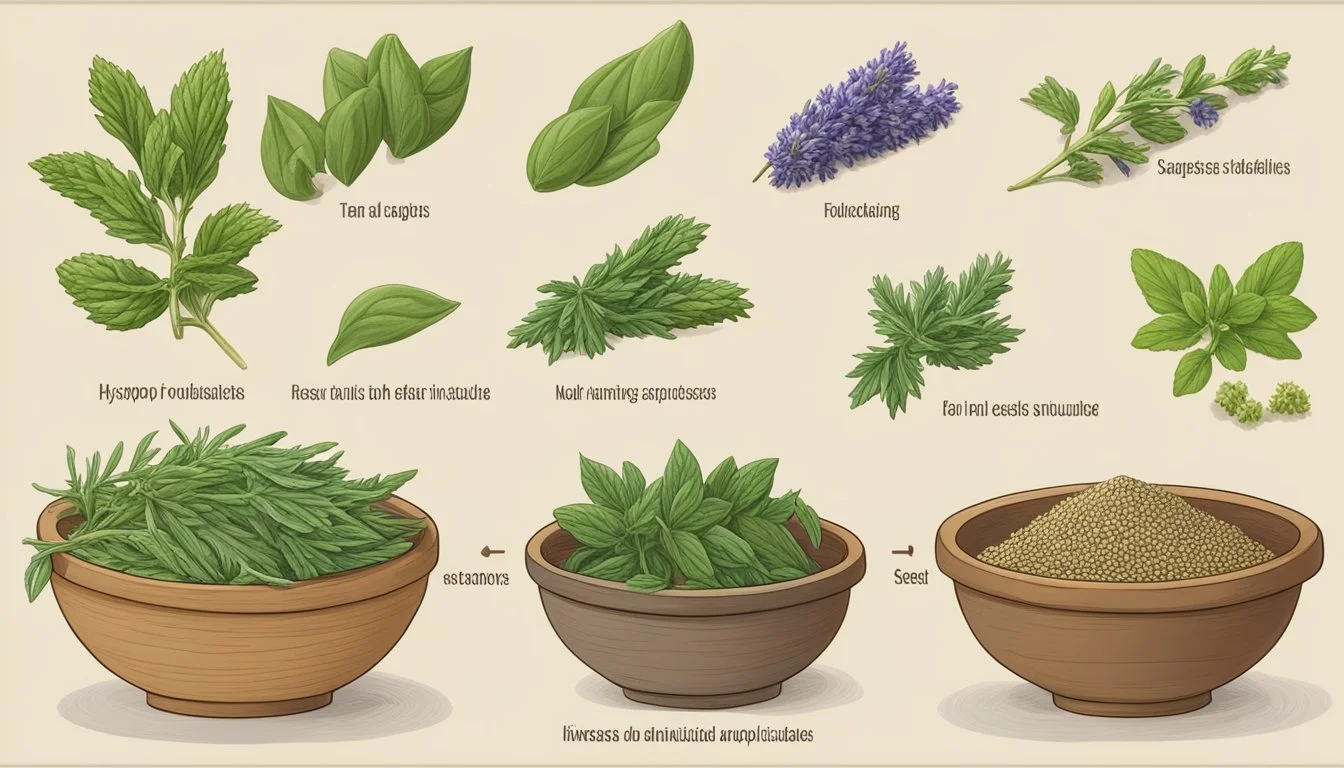Hyssop Seeds Substitutes
Best Alternatives for Your Recipes
Finding the perfect substitute for hyssop seeds can be easier than you think. When Hyssopus officinalis, or hyssop, isn't available, there are several herbs that can step in to enhance the flavor of your dishes. For instance, marjoram—a herb known for its mild flavor and slight sweetness—can be used in a 1:1 ratio, retaining the desired taste without overpowering the dish.
Lavender, another member of the mint family, makes for an excellent alternative as well. Its aromatic profile closely matches that of hyssop, providing both culinary and ornamental benefits. When substituting with lavender, whether fresh or dried, a 1:1 ratio works seamlessly.
Other herbs such as fennel seeds, known for their licorice-like taste, can also serve as viable substitutes. Particularly in savory dishes, fennel seeds mimic the aniseed-like flavor of hyssop seeds effectively. Embracing these alternatives can keep any herb garden versatile and ensure that recipes remain flavorful no matter what ingredients are at hand.
Understanding Hyssop
Hyssop, known scientifically as Hyssopus officinalis, is a versatile herb belonging to the Lamiaceae or mint family. It is valued for its aromatic properties and is used in various culinary, medicinal, and ornamental applications.
Botanical Profile
Hyssopus officinalis is a compact, semi-evergreen sub-shrub. It typically grows to a height of 18 to 24 inches (45 to 60 cm). The plant has a somewhat woody growth habit and produces small, aromatic leaves. These leaves are used in numerous applications, both culinary and medicinal. The flowers, varying in shades from blue to purple, bloom during the summer months, attracting bees and other pollinators. The plant thrives in well-drained soil and requires full sun to partial shade.
Hyssop in Culinary Use
Hyssop's aromatic leaves infuse dishes with a mildly minty, slightly bitter flavor. It is used in both fresh and dried forms to season soups, stews, and meat dishes. When cooking with hyssop, it's important to use it sparingly to avoid overwhelming the dish's flavor. Besides its use in solid foods, hyssop is also a popular choice for herbal teas and infusions. Its distinctive taste pairs particularly well with other herbs in the Lamiaceae family, such as rosemary and marjoram.
Hyssop's Health Benefits
Hyssop has been traditionally utilized for its health benefits. It contains essential oils that are believed to have antimicrobial and anti-inflammatory properties. The plant is often used in the form of organic hyssop essential oil or dried leaves to prepare infusions and teas. These preparations are commonly employed to relieve respiratory conditions, aid digestion, and boost immune function. Modern research supports some of these uses, particularly the plant's potential in supporting respiratory health and its role in treating minor digestive issues.
Substitutes for Hyssop in Cooking
Hyssop seeds are prized for their delicate minty flavor and aromatic qualities. Various herbs can serve as suitable substitutes when hyssop is unavailable, enhancing the taste of both savory and sweet dishes.
Substituting for Hyssop's Minty Flavor
For those looking to mimic hyssop's distinct minty flavor, certain herbs can be quite effective. Mint itself is an obvious choice. It adds a refreshing taste without overwhelming other flavors in a dish.
Mild varieties of mint work well in salads and desserts.
Marjoram is another excellent option. Its mild flavor and hint of sweetness complement many dishes without overpowering them.
Use a 1:1 substitution ratio to start, adjusting according to taste.
Herbs with Similar Aromatic Profiles
Hyssop is not only minty but also aromatic. Lavender can replace hyssop in recipes where the aromatic profile is essential.
Use dried lavender in equal amounts to hyssop when substituting.
Sage and rosemary also bring potent aromas and are often readily available. Sage has a slightly peppery flavor, making it suitable for more robust dishes.
Thyme works well too. Its earthy and slightly minty flavor makes it a versatile substitute.
Hyssop Alternatives in Meat Dishes
When cooking meats like lamb or creating marinades, rosemary stands out as a top substitute. Its strong, camphor-like flavor pairs well with roasted meats and potatoes.
Thyme is perfect for lamb and other meat dishes. It enriches the dish's flavor without overshadowing the natural taste of the meat.
Lavender also proves useful in marinades. Its subtle, sweet aroma complements meat well.
Experimenting with these herbs can lead to delightful variations in flavor, enhancing your culinary creations while maintaining the essence that hyssop brings.
How to Choose the Right Substitute
Selecting the ideal hyssop substitute involves evaluating the dish type, balancing flavors, and ensuring accurate measurements. Each aspect is crucial to maintaining the integrity of your culinary creation.
Considering the Dish Type
Different dishes benefit from specific herbs. In soups and savory dishes, rosemary or marjoram can complement the flavor profile well. For salads or marinades, using more subtle herbs like dried thyme might be preferable.
Example: When preparing a herb-roasted chicken, rosemary offers a pungent and intense flavor that's perfect for meats. On the other hand, for a light lemon vinaigrette, marjoram will integrate seamlessly without becoming overpowering.
Balancing Flavors and Intensity
Hyssop has a strong and bitter taste, so it's essential to choose substitutes that won't clash with the existing flavors of your dish. Some substitutes, like rosemary, can be quite intense and should be used in moderation. If the recipe calls for a fresh herb, use fresh lavender or marjoram for a similar aromatic experience.
Flavor profiles to consider:
Rosemary: Pungent, camphor-like, great for roasted meats.
Marjoram: Mild, hint of sweetness, ideal for balancing delicate flavors.
Dried thyme: Earthy, slightly minty, versatile for soups and stews.
Substitute Ratios and Measurements
Accurate substitution ratios are critical for maintaining flavor balance. Start with a 1:1 substitution ratio for dried herbs, such as using dried lavender or thyme in place of dried hyssop. For fresh herbs, the same 1:1 ratio generally applies, but always adjust according to taste since fresh herbs can vary in intensity.
Example:
Dried hyssop to dried thyme: 1 tsp to 1 tsp.
Fresh hyssop to fresh marjoram: 1 tbsp to 1 tbsp.
When substituting, remember that herbs like rosemary are more intense and might require less than a direct 1:1 swap. Adjust seasonings like salt accordingly to ensure a balanced dish.
Common Substitutes for Hyssop
When hyssop is unavailable, several alternatives offer similar flavors and culinary uses. Options include various herbs and seeds that can seamlessly replace hyssop in recipes.
Alternative Herbs
Marjoram is a mild herb with a hint of sweetness and can replace hyssop without overpowering your dish. A 1:1 substitution ratio is recommended, adjusting to taste if necessary.
Sage provides an earthy, slightly peppery flavor. It pairs well with savory dishes. Use it in equal amounts to hyssop but consider reducing if it becomes too overpowering.
Basil is another substitute, particularly good for dishes where a fresh, aromatic flavor is desirable. It works well in salads and as a garnish. Start with a 1:1 ratio.
Oregano offers a robust, slightly bitter taste. It's suitable for Italian and Mediterranean dishes. Use it sparingly, as it can be strong.
Thyme has a subtle flavor with hints of lemon and mint. It complements meats and vegetables well. Substitute in equal amounts, adjusting based on recipe requirements.
Seed-Based Substitutes
Sesame Seeds can replace hyssop in some recipes, especially for adding texture and a mild nutty flavor. They work well in baked goods and as a topping for dishes.
Hemp Seeds provide a slightly nutty flavor and are rich in protein, making them a suitable substitute in health-focused recipes. They can be sprinkled over salads or blended into dressings.
Sunflower Seeds offer a crunchy texture and mild taste, suitable for garnishing or adding to baked items. Use them as a 1:1 substitute where texture is important.
Pumpkin Seeds are another option, providing a nuttier taste and crunchy texture. They are excellent in salads, soups, and as a snack. They can be used whole or ground to match the recipe needs.
Recipes and Applications
Hyssop seeds can be substituted with a variety of other herbs and ingredients across different culinary applications. These substitutions allow for creativity and flexibility in recipes such as infusions, teas, and baked goods.
Infusions and Teas
Lavender is a popular alternative for hyssop in infusions and teas. Its floral notes provide a soothing, aromatic experience. Use dried or fresh lavender petals in a similar quantity as you would hyssop seeds. Lemon balm and mint also work well, offering a pleasant twist. These herbs can be used in liqueurs to add nuanced flavors. Chamomile is another great option for teas, imparting a sweet, apple-like taste that enhances relaxation.
Culinary Inspirations
In culinary dishes, thyme and oregano are excellent substitutes for hyssop seeds. Their robust flavors make them ideal for marinades, soups, and vegetable dishes. Tarragon, with its mild licorice note, is perfect for salad dressings and dips. A combination of rosemary and savory can also be used to match hyssop’s intense flavor in grilled meats and hearty stews. Each herb ensures the dish remains vibrant.
Baking with Hyssop Substitutes
When baking, consider using lavender or anise seeds in place of hyssop seeds. These substitutes bring a distinctive flavor to cakes and other baked goods. Lavender’s floral notes enhance the sweetness of desserts, while anise imparts a mild licorice flavor. Licorice root powder can also be used sparingly for a similar effect. These substitutions allow for creative and delightful variations in recipes without compromising taste.
Growing and Harvesting Substitutes
Choosing the right substitutes for hyssop can significantly impact their cultivation and harvesting processes. Understanding the specific needs of each substitute ensures a successful growing season and optimal harvest.
Cultivating Substitutes at Home
Marjoram, lavender, and mint are popular substitutes that can be easily grown at home.
Marjoram requires full sun and well-drained soil. Plant seeds after the danger of frost has passed.
Lavender thrives in full sun and slightly alkaline soil. It is important to space plants adequately to ensure good air circulation.
Mint prefers partial shade to full sun and moist soil. It is advisable to plant mint in containers to control its spread.
These substitutes, such as lavender and mint, can be deer-resistant and attract beneficial insects, making them excellent additions to a garden.
Harvesting and Storage
Each substitute has unique harvesting and storage requirements.
Marjoram: Harvest leaves before the plant flowers. Use fresh for cooking or dry for later use. Store dried marjoram in an airtight container.
Lavender: Harvest flowering stems when the buds are just opening. Dry for use in dried herb collections, dry rubs, or cooking. Hang bundles upside down in a dark, dry place for best results.
Mint: Harvest leaves before they flower. Use fresh, or dry them for storage. Store dried mint in a cool, dark place in airtight containers.
Proper harvesting and storage techniques ensure the herbs retain their flavors and properties, making them ideal for culinary applications and other uses.
Cultural and Historical Context
Hyssop has been valued throughout history for its medicinal properties and use in various cultural cuisines. Its significance spans ancient texts, rituals, and regional dishes.
Hyssop Throughout History
In biblical times, hyssop was highly regarded for its purifying properties. It is mentioned several times in the Bible, particularly in Psalms and Exodus, where it was used in cleansing rituals. Ancient Hebrews used it for purification rites, symbolizing holiness and repentance.
During medieval times, hyssop became integrated into Latin theology and liturgy. It was often linked with spiritual cleansing and protection against evil spirits. In the Middle East, hyssop was utilized both for religious ceremonies and traditional medicine, known for its supposed ability to ward off negativity and promote respiratory health.
Hyssop in Cultural Cuisine
In Mediterranean cuisine, hyssop has a distinct role. It's a key ingredient in za'atar, a popular herb mix in Middle Eastern dishes. This spice blend, combining dried hyssop with sesame seeds, thyme, and sumac, adds a tangy flavor to bread, meats, and vegetables.
Traditional recipes often feature hyssop due to its aromatic and slightly bitter taste. Its leaves can be added fresh to soups and stews or dried and used as a seasoning. The herb's medicinal uses also extend to culinary purposes, with hyssop tea being consumed for its potential respiratory and digestive benefits.
Hyssop's varied applications highlight its importance across different cultures and eras.
Nutritional and Health Considerations
Choosing suitable substitutes for hyssop seeds involves understanding their nutritional content and potential allergens. This section highlights the health implications of various alternatives, focusing on their nutrient profiles and suitability for specific dietary restrictions.
Nutritional Content of Substitutes
Hyssop seeds are not commonly studied for their nutritional content, but informed choices can be made with commonly available substitutes.
Chia Seeds: These are rich in protein, omega-3 fatty acids, and fiber. They also provide essential minerals like calcium and magnesium.
Nutrient Amount per 28g (1 oz) Protein 4.7g Omega-3 Fatty Acids 5g Fiber 11g
Flax Seeds: Also high in omega-3s, flax seeds include lignans, which have antioxidant properties. They're a good source of protein and dietary fiber.
Lavender: While not a primary nutrient source, lavender offers some vitamins such as vitamin A and is often used for its aromatic properties.
Allergens and Dietary Restrictions
When selecting a substitute, consider potential allergens and dietary restrictions.
Chia Seeds: Generally safe but can cause choking if not prepared correctly. They absorb water and expand, so they should be hydrated before consumption.
Flax Seeds: Some individuals may have allergies to flax seeds, and they should always be ground to ensure proper digestion and absorption of nutrients.
Lavender: Rarely allergic but can interact with certain medications. Always check for potential drug interactions.
Additionally, using substitutes like chia or flax seeds instead of hyssop seeds often caters to vegan diets due to their plant-based nature. However, care should be taken when using cheesecloth bags to strain these seeds, ensuring all small particles are removed to avoid choking hazards.
Practical Cooking Tips
When substituting hyssop seeds in recipes, it is crucial to know how to adjust the quantity and manage the herb’s characteristic intensity to maintain the dish's intended flavor profile.
Adjusting Hyssop in Recipes
The unique flavor of hyssop can be challenging to replicate, but substitutes such as marjoram or rosemary can be utilized effectively. Marjoram offers a mild and subtle sweetness. Use a 1:1 substitution ratio to start, and adjust as needed based on taste.
Rosemary has a stronger, more pungent aroma. Begin with a smaller amount, gradually increasing to avoid overpowering the dish. Tables can be helpful when determining quantities:
Substitute Starting Ratio (Hyssop) Marjoram 1:1 Rosemary 1:0.5
Ensuring the right balance will help maintain the recipe's original intent.
Dealing with Hyssop's Intensity
Hyssop can deliver a potent punch, which might not be suitable for all palates. When using intense herbs, less can often be more. If a recipe calls for cooked hyssop, remember that its intensity can be mellowed by heat, especially in braising liquids.
To balance flavors in more delicate dishes or those requiring a lighter touch, consider pairing hyssop substitutes with other herbs. Incorporating milder herbs such as parsley or basil can help diffuse intensity while enriching the overall flavor profile.
Adjusting the ratio and considering the cooking method can make a significant difference in controlling the final taste.











